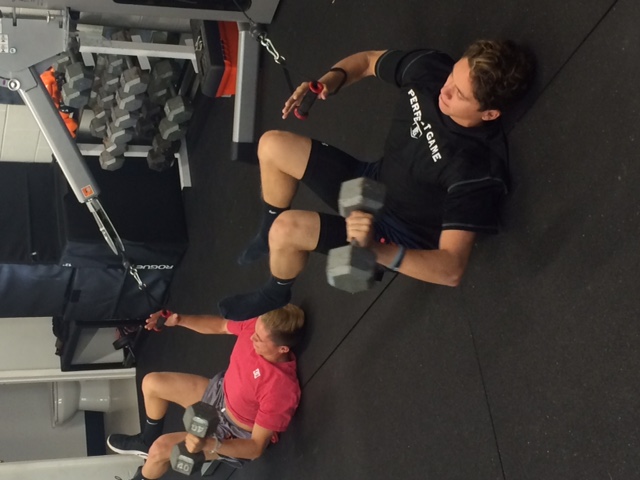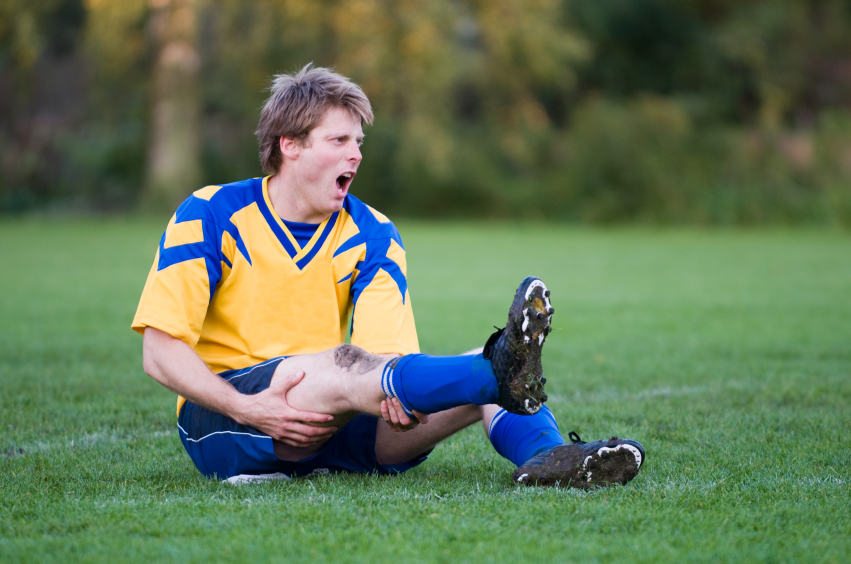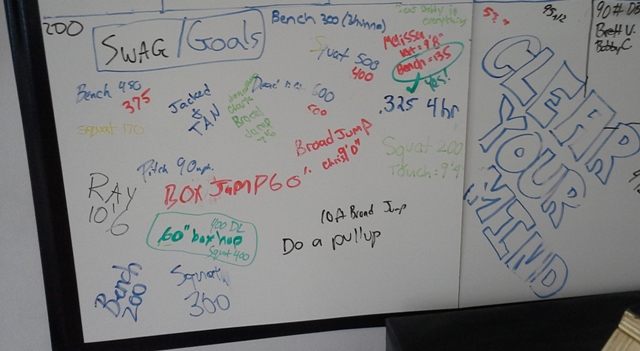At 27 years old, I am currently training to bench 450, have a 10 foot standing broad jump, have a 62 inch box jump, squat 500 lbs, and dead lift 600. Melissa is training to make the pro beach volleyball tour, touch 9’8”, and bench 135 lbs. Chris Gibson wants to bench 350 and lose 20 lbs, Brett Vulgar wants to have a 60 inch box jump, Krista Morrison wants to squat 170 lbs 10x, and Justin Page wants to throw 90 mph. Why am I telling you this? It holds these people accountable for their goals. Why do I care about goals? They keep me motivated as a strength coach and a person.
Goals and Motivation
At 27 years old I am currently training to bench 450, have a 10 foot standing broad jump, have a 62 inch box jump, squat 500, and dead lift 600. Melissa is training to make the pro beach volleyball tour, touch 9’8”, and bench 135. Chris Gibson wants to bench 350 and lose 20 pounds, Brett Vulgar wants to have a 60 inch box jump, Krista Morrison wants to squat 170 10 times, and Justin Page wants to throw 90 mph. Why am I telling you this? It holds these people accountable for their goals. Why do I care about goals? They keep me motivated as a strength coach and a person.
Why set a goal?
Setting a goal is one of the single greatest tools any athlete or individual can use to stay excited and motivated while they train. It keeps you hungry and gives you a mark to shoot for. I’ve had people tell me they weren’t goal oriented, that is impossible. You are either suppressing your vision, or are just simply not motivated to live. And honestly, if that’s true, there is something else going on.
Pulling out yoru goals
When I’m not at my gym, I am at Naval Base Point Loma, working with soldiers dealing with PTSD. Every 4 weeks I meet with a new group of guys and girls of all different ranks. They come into the program, thinking they will have their own “personal trainer”. As anything strength coach would, because we all have egos, the first thing I do is explaining the difference between a personal trainer and a strength coach. I then show the group some magic so they know they will be seeing improvements in their movement quality fast, and letting them know I am not there rah rah 3 more, 2 more reps, kind of guy. For the next 8 weeks that know they will be given a tremendous opportunity to change their lives, have kick ass exercise programs, they will experience real what real strength and conditioning is and feels like, see how they can actually lift without pain, and most importantly build friendships that I will never forget.
Finding Motivation
The single most important day I have with the guys, is when we meet 1 on 1 and talk about training, goals, and motivation. Some of the guys I meet with have zero motivation before we talk. I truly mean zero. No motivation to train and some have a lack the desire to get out of bed in the morning.
Some guys initially tell me they have no goals and no motivation, while others have a clear vision to what they want to accomplish. Losing weight, bench 300, running an 18 minute 3 mile, look like a 19 year old porn star, I’ve heard it all. These guys make my life easy.
What do I do for guys without motivation, and have no trust or faith in me? Well that gets a little deeper, but motivation is often then found in their family, and kids. It goes a little like this. “Are you married?” if yes, bam, motivation. “Do you have kids?” If yes, bam, motivation. Once this motivation is found the goals start rolling off their lips.
As for the trust, that comes in time, by doing a good job, and showing my guys that I will do anything at anytime to help them along their journey here, and for the rest of their lives.
Sharing is Caring
The power of setting a goal grows over time. How? By sharing them. I tell my athletes, friends, and family what I want to do. I along with my athletes, write it down on the goal board in the gym in big letters. There is no running or hiding from your goals. Sharing your goals forces you to be held accountable for your actions! Personally, I hate failing, I don’t know many who actually enjoy it. So make sure those goals are attainable.
Be S.M.A.R.T.
There is an age old acronym to help you set your goals, S.M.A.R.T. Tis simple acronym helps you create a solid goal. To help understand the acronym I will use my own goal of benching 450.
S- Specific. Bench 450
M-Measurable 450 is pretty measurable to me
A – Action oriented. My actions in the gym will allow me to reach that goal
R – Realistic. I have benched 400 in the past, and there are guys who bench 1000. Absolutely realistic
T- Time Based. I didn’t set a specific time line but the sooner the better!
Try it out with your current training goal. See if it fits. If not, maybe it should be adjusted.
Here are some other goals that fit the SMART acronymn. Hit 90 mph by the time the season starts. Lose 18 pounds within the next 24 days. Squat 465 by August 1. Play in, and place well, in an AVP qualifier by the end of the summer
Post Goal hang over
There is danger with setting and reaching your goal. Where do you go next? I have known a few people (myself included) to reach a goal, then carry on with their regular old life. 6 months later you realize you can no longer lift that weight, or that weight has crept back on.
Goals are meant to be mile stones in your life. They are meant to be achieved. When you achieve a goal, don’t become satisfied. Continue to push, and set new higher goal. Continue to raise the bar! (pun intended) Obviously, it is not realistic to bench 1000 pounds every day. But it is realistic to continue to train hard so it isn’t so far out of reach. The key is to stay hungry. If you pass a goal, celebrate the passing but then set a new one! A new goal that will keep you hungry, motivated, and training hard.
Conclusion
Find motivation and set a goal! Goals are powerful and will keep you motivated
Make sure your goal is S.M.A.R.T
Share your Goal: the more the merrier! Write it down and share your goal with friends and family
Reach your goal: Get to your goal and don’t let anything get in your way!
Set a new goal and fight off the Post Goal Accomplishment Hangover: Celebrate your goal then set a new goal.
Continue to raise the bar!!
Have a strong day!








